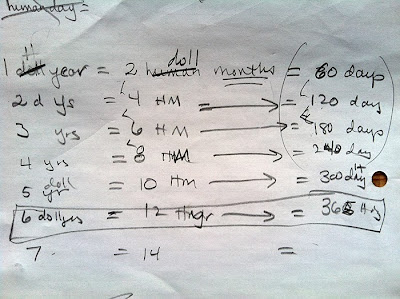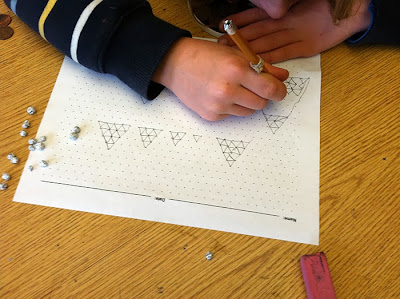I've just started a book project. What's it about? Well, for now, I think it's about digging into the whys and hows of learning math and dance at the same time. This may change, but that's where I'm at right now.
To organize and clarify my thoughts I've been doing quite a bit of background reading, having e-mail/online conversations with various wonderful people, and drafting some preliminary chapters in the blissfully serene Silent Reading Room at our local public library. Tons of natural light, total silence except for the hum of the HVAC and the occasional cough.
One day last week I sat down to read and felt that old feeling coming on that I used to get in college. It signifies I am completely saturated and overwhelmed with thinking, reading and writing. It makes me a bit crazy, honestly. To combat it, I've learned to skim text and only read closely when I need specific information. Even better, go for a long, long walk with far away vistas.
I call that part of my brain my
'word-mind' and it is very clearly located in my head.
Using my word-mind is a completely different experience from thinking with my
body-mind. I know, because after college I started dancing and was introduced to another part of the thinking equation -- the body thinks too, a phenomenon that is defined and described by studies in embodied cognition (a branch of cognitive science).
The body thinks, too. This was truly a revelation to me.
Ultimately, there were years (and years) where I was required to use only my word-mind to learn. And then there were bunches of years (as an adult) where I learned and expressed myself solely through my body mind (dance and music performance, never wanted to get on the mic to talk). My body-mind thinks differently than my word-mind, but what I have come to realize is that, in addition to needing to find a balance between the two in my daily life,
as a learner I learn best when I am using both at the same time.
..........................
I was in Minnesota this summer, sharing my work with a group of teachers and teaching artists. That's when I met
Christopher Danielson in person. Yes, an educator of math educators came to my workshop. I was a wee bit nervous but I needn't have worried. Even though in my workshops we make dance and math for a large proportion of the time, Christopher was game to dance and dance he did. He also took copious notes by hand at various intervals. I was again a wee bit worried, but it turned out our 90 minutes of dance and math making had gotten him thinking. In a good way.
By engaging with the work of Math in Your Feet from the inside of the experience instead of simply watching, he generated many new questions that moved his thinking forward in new ways.
The next day we met for a breakfast conversation during which, in relation to one of the questions he had while dancing, Christopher mentioned a now defunct unit in the Connected Mathematics series that investigates transforming squares in a series of combinations and is related to the thinking in modern algebra. Later, he sent me the book. I meant to get started on it but life took over. And then
my book took over.
...........................
This week my word-mind gave out. I was literally a little dizzy from thinking in my head and was completely DONE with words. I do a lot with language these days. I keep a blog, I'm active on Facebook and Twitter, and I edit a year-round, international online writing project for the
Teaching Artist Journal. So to have reached my limit with words is saying something.
I needed something completely different to do.
I pulled the Connected Mathematics book off my desk, sharpened my pencil and headed for the library. I made my little square out of nice stiff paper. I labeled the vertices. I combined series of turns and flips, filled in the table and investigated the patterns I saw. For a good portion of the time I was completely frustrated and confused -- turns out I was turning clockwise when I should have been turning counter. Apparently there is some convention among mathematicians that all rotations go counterclockwise. They must have all been left handed and never learned analog (clockwise) time because
this right dominated person kept seeing the "R" for rotate as meaning "turn RIGHT."
At some point, though, I was looking at my hands, turning, flipping, holding corners to orient them as I turned and flipped, and I realized I was in some kind of zone. I was talking to myself in words: specific conscious reminders to turn left when rotating, murmuring less conscious words while filling in the chart, a gentle narration as I talked myself through each new sequence of flips and turns and, eventually, the body and words merged and I was
just doing. I had fallen into a zone of concentration while making math that mirrored what often happens when I am learning something new in dance.
After making numerous combinations of transformations with my hands, I now have a new feel for what a square is and is capable of. Both the word-mind and the body-mind had a part to play in this new understanding.
I hope it is obvious that this is not an either/or kind of story -- it's about both. Understanding cognition and thinking and knowing is a vast endeavor and I don't know if we will ever fully understand the complexity of it all.
My focus is on what it means and looks like to learn math with the body as an equal partner and to do this I need to keep the body's way of knowing and thinking firmly in my sights.
Ultimately, what I am wrestling with is this:
We can
see the body moving, but most of us have not yet learned
how to look at and understand the knowing and learning happening while the body moves. It's an
inside process and not one that a child will necessarily be able to tell you about. As more experienced learners the onus is on the adults to look for how children show us what they know and think with all their
one hundred languages, including the body.
I'll leave you with a powerful paragraph found in the conclusion of the recent study
Children's Gestures and the Embodied Knowledge of Geometry (bolding emphasis mine):
"Despite two decades of research on the embodied nature of cognition, constructivist perspectives continue to emphasize abstraction of knowledge from the physical engagement with the world ... In this way, constructivism orients our attention away from the body, concerned as it is with the construction of mental entities and representations...
Once we acknowledge the body as the seat of knowledge itself rather than as a stepping stone to abstractions, it is possible to organize teaching differently. In doing so, [this] brings forth the possibility of inquiring into such questions as, 'What might we do to recognize and understand children's knowledge expressed in modes other than speech or writing?'"
One thing you can do is to try learning math and dance at the same time yourself. I'm available to talk about how I can help, if you like. Feel free to
get in touch.











































